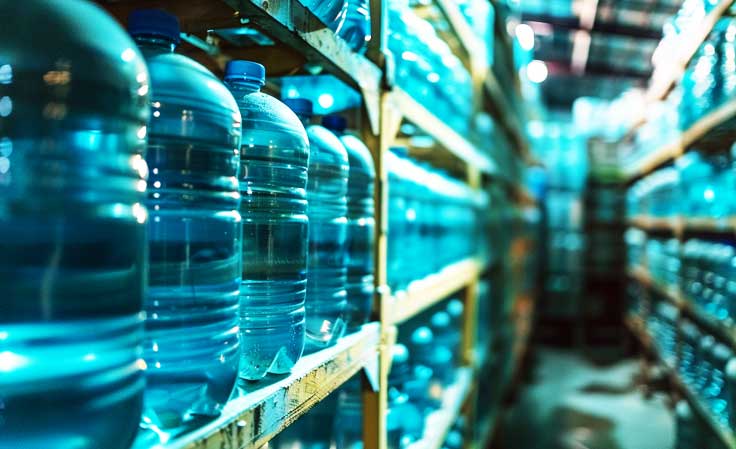Emergencies can strike unexpectedly, leaving us without access to essential resources. Among these, water is perhaps the most critical. Whether it's a natural disaster, power outage, or unforeseen circumstances, having a reliable supply of stored water can be a lifesaver.
Last summer, my water went out due to a broken under-ground pipe. Water is a vital resource, but because I prepped ahead of time, I was still able to carry on as normal. I could wash my dishes, refill my animals’ water, and clean as I needed.
In this blog, we'll explore the importance of water storage for emergencies and provide you with a comprehensive guide on how to store water effectively.
Determining Your Water Needs
In an emergency, it's crucial to know how much water you need to store to ensure the well-being of your family. The first step is calculating your daily water consumption.
On average, a person requires at least one gallon (approximately 3.8 liters) of water per day for drinking and sanitation. Consider the number of people in your household and factor in the expected duration of the emergency to determine your total water requirement.
Do not forget to consider your pets. Depending on their size and activity, factor in a half gallon to one gallon of water per day per pet.
Choosing the Right Containers
Selecting suitable containers for water storage is essential to maintain water quality. Food-grade plastic containers, such as those designed for storing beverages or water, are ideal.
Avoid using containers that once held chemicals or non-food items, as they may contaminate the water. Ensure that containers are clean and free from any residue before use.
Before using the containers, you can rinse out with warm, soapy water to ensure any debris or manufacturer residue is out of the container.
Ensure you rinse well enough to get all of the soap out of the container. Rinse thoroughly.
Water Treatment and Purification
Before storing water, it's essential to treat and purify it to prevent microbial growth. You can use common household bleach, iodine, or water purification tablets to disinfect the water.
Follow the recommended guidelines for the right dosage and contact time. This step is crucial, especially if you are using tap water for storage.
If you don’t feel comfortable using these purifiers, you can rotate the water out every six months to ensure that fresh water is going into the containers and it isn’t sitting for long periods of time.
Filling and Sealing Containers
When filling containers with water, leave a small space at the top to allow for expansion as water freezes. Seal the containers tightly to prevent any contaminants from entering.
Make sure the lids or caps are secure and airtight. Label each container with the date of filling to keep track of rotation.
Ideally, you will want to store in an area where your water won’t freeze, but if your only option is an outdoor shed or area, then ensure you have room for freezing expansion.
Keep this in mind if you need your emergency water and the time for unthawing. You will need a warm area to dethaw your water.
Storage Location
Choose a suitable location for storing your water containers. It's best to keep them in a cool, dark place away from direct sunlight and extreme temperatures.
Extreme heat can cause plastic containers to break down, affecting water quality and taste. Be mindful of the weight of filled containers, as water can be heavy.
Regular Inspection and Rotation
Maintaining your stored water is as important as initially storing it. Regularly inspect containers for any signs of damage or leakage. Additionally, rotate your water supply every six months to a year to ensure freshness.
Use the older water for non-drinking purposes and refill with fresh water.
When my water was shut off, I was able to use the older water to wash dishes and clean my house. It is important to inspect your water for any discoloration, smell, or growth.
Inspect your containers as well to ensure there is no mold growth in any cracks or crevices.
Alternative Water Sources
While stored water is essential, you should also explore alternative water sources during emergencies. Rainwater harvesting, if legal in your area, can provide a renewable supply.
Additionally, urban areas may have hidden sources like hot water tanks, ice cubes, and even toilet tanks that can be used in a pinch.
Keep a portable water filter like a LifeStraw in your bug-out bag in case you have to leave your shelter in a pinch. Having a portable water filter will allow you to safely consume water from various resources.
In times of crisis, access to clean water is non-negotiable. By taking proactive steps to store water for emergencies, you're ensuring the safety and well-being of your loved ones. Remember that preparedness is the key to resilience.
Start your water storage plan today, and gain the peace of mind that comes with knowing you're ready for whatever comes your way. Don’t forget to include your pets in your water storage plan!
FAQs
How much water should I store per person per day for emergencies?
On average, plan for at least one gallon (approximately 3.8 liters) of water per person per day for drinking and sanitation.
Can I use tap water for long-term storage?
Yes, you can use tap water for storage if you properly treat and purify it to prevent microbial growth.
What are the best containers for water storage?
Food-grade plastic containers designed for beverages or water are ideal for water storage.
How often should I rotate my water supply?
It's recommended to rotate your water supply every six months to a year to ensure freshness.
Are there any natural sources of water in urban areas during emergencies?
Yes, you can explore alternative sources like rainwater harvesting, hot water tanks, ice cubes, and toilet tanks in urban areas during emergencies.

